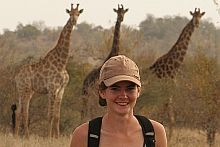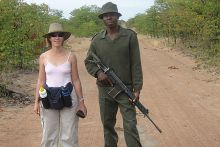Mopane mapping project enters its second year
|
Following the great success of our Mopane Range Expansion Project in 2008, SAEON Ndlovu Node embarked on the second year of this project.
As Colophospermum mopane is one of the trees that is expected to extend its distribution range southwards in response to climate change, it is a logical tree to monitor, especially as it is so common. The project aims to map blocks of mopane along its southern boundary in order to establish a baseline from which to detect shifts in this plant’s distribution.
Results from the mapping in 2008 show that mopane has a very specific relationship with elevation only at the southern distribution limit. This finding also opens up a new way in which we can monitor mopane response to climate change.
To learn more about the distribution of mopane we have also started mapping areas away from its southern limit, where the population is not stressed by occurring at the edge of the species’ distribution.
SAEON volunteers
Mapping in 2009 therefore took place in and around the Phalaborwa region as well as in the Olifants region. This year Ndlovu had two permanent volunteers, Calley Jones (project manager) and Jenny Lancaster. They worked with Godfrey Sekhula, an experienced game guard and ex-field ranger who kept them safe during numerous elephant and lion encounters.
Jenny is just in the process of completing her PhD on small mammals at the University of the Witwatersrand. Prior to starting at SAEON she was working as a lecturer at the Organization for Tropical Studies (OTS). Not wanting to leave the bush for the interim time between OTS lecturing stints, she decided to assist with the mopane mapping project.
Calley Jones, an American student in her fourth year at Meredith College in North Carolina, says that six months ago she had no idea what a mopane tree was. In January this year she came to South Africa for the first time as part of an OTS initiative. “OTS gave me a solid introduction to South Africa, savanna ecology, and the Kruger National Park,” she says.
In the course of the programme she met Nikki Stevens of the SAEON Ndlovu Node as a guest lecturer speaking to the class about mopane trees. Although she found Nikki’s lecture interesting, it was not really relevant to her goal of becoming a veterinarian. However, fate stepped in:
“Over the four months of the course I fell in love with South Africa, and wasn’t yet ready to leave," Calley says. "Nikki needed a project manager for SAEON’s mopane mapping project and here I am. For the past month I have had the privilege of walking the bush of Kruger National Park. From lions to boomslangs to knobthorn trees, it has been an adventure."
“And besides having had a great time, we’ve gathered some interesting data about the distribution of mopane trees.”












